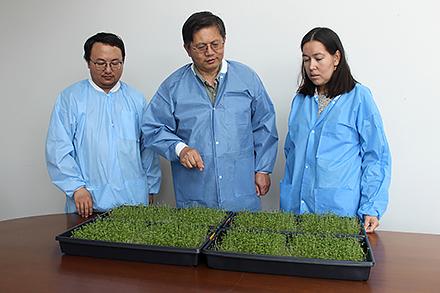Baby Broccoli Brings Beneficial Boost

Tianbao Yang, plant physiologist, (center) examines broccoli microgreens with two postdoctoral researchers, Xudong Zhu (left) and Irma Ortiz (right). (Photo courtesy of Tianbao Yang)
Microgreens Offer Chance to Grow Vegetables for Customized Health Needs
Broccoli is well known for its particular flavor, healthy properties, and ability to help ward off certain types of cancer, but there's more to this veggie than the florets found in salad bars, stir fries, and your favorite broccoli cheese soup.
As proof that good things can come in small packages, baby broccoli — one type of "microgreen" — packs as much as four times the number of cancer-fighting antioxidants as its adult counterpart. On top of that, you can grow them easily and rapidly to ensure that you have a ready supply.
"Broccoli microgreens are young and tender greens harvested when the first true leaf appears," explained Tianbao Yang, plant physiologist at the Agricultural Research Service's Food Quality Laboratory in Beltsville, MD. "As compared to their mature counterparts, broccoli microgreens contain higher amounts of phytonutrients and minerals."
Phytonutrients are natural compounds in plants that may help prevent disease. In particular, broccoli contains large amounts of glucosinolates, which change into other chemicals during the cooking process and digestion. Studies have shown that these chemicals help reduce the development and growth of various diseases, including prostate, breast, colon, skin, bladder, and oral cancers.
According to Yang, glucosinolates are antioxidants mainly found in cruciferous plants, such as broccoli, kale, radish, and cabbage. Epidemiologic studies suggest a correlation between consuming broccoli with reduced effects of aging, asthma, and other chronic pulmonary diseases.
These natural health benefits are not hard to find, Yang said. "Microgreens are easy to grow and handle and have a short production cycle. They are a good choice for urban farming and controlled environment agriculture."
Microgreens may be an option for people who want to garden but have limited — or no — outdoor space to grow their own produce. Home gardeners can grow microgreens indoors or outside, in soil or hydroponically— that is, in water. Not only that, but broccoli microgreens may be ready to harvest in as little as a week. Information on hydroponic gardening is readily available from many online sources.
Yang offered two simple tips that home gardeners can use to get even more healthful benefits from their baby broccoli: adding calcium salt to the hydroponic solution or applying it as a spray; and/or putting the sprouts under ultraviolet B (UVB) light for 1-2 hours per day.
Both calcium salt and UVB induce a stress response in the plants that promotes the production of glucosinolates. The methods can be used together or separately.
Yang believes that, in the future, it could be possible to grow personalized vegetables for specific populations with chronic diseases.
"Fruits and vegetables are an important part of diet," Yang said. "They are rich in a variety of phytochemicals and minerals that are beneficial to human health. Controlled environment agriculture provides the opportunity to manipulate plant growth conditions and design beneficial nutrients. Microgreens are one of the best candidates for this." — By Scott Elliott, ARS Office of Communications
You May Also Like:

